Smoked salmon in all its forms is considered festive fare, and is perfect for a special occasion brunch or a luxurious cocktail snack. Cured fish has been prepared for centuries as a means of food preservation. Thanks to refrigeration and our knowledge of food safety temps, fish is much safer to eat now than it was a couple of hundred years ago. We have the key temps and tips necessary to make sure your smoked salmon has a fine texture and full, rich flavor. Perfect for a Sunday morning buffet or breakfast in bed.
Curing Salmon for Smoking
The first step in preparing smoked salmon is the salt cure. It’s obvious that a little salt and sugar will add flavor to the fish, but what’s going on under the surface is worthy of a little scientific exploration. Salt-curing (packing fish in a dry mixture of salt and sugar), and smoking are a means of preservation for a reason.
➤ Salt and Sugar at Work:
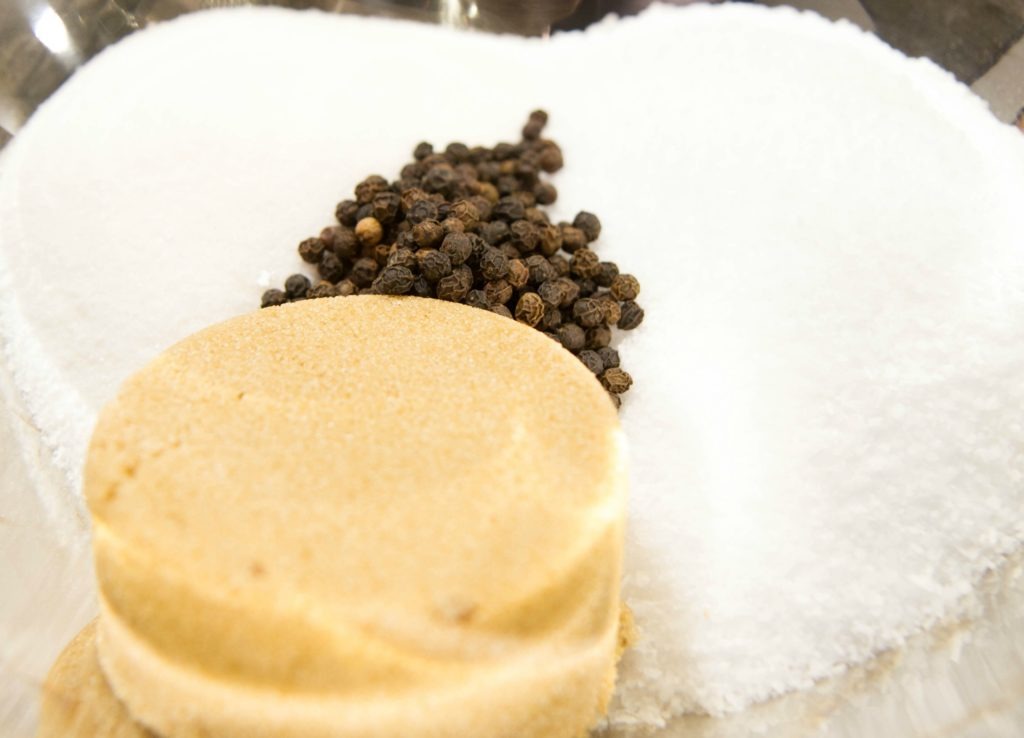
The salt draws moisture out of the fish—including out of any microbial cells. As the unwanted bacteria die, beneficial bacteria move to the forefront, consuming the sugar in the cure. The lactobacillus bacteria (good bacteria) that grow create a more acidic environment that is even more inhospitable to the harmful bacteria.
➤ The Function of Smoke:
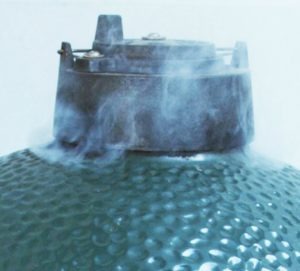
Smoking meat and fish is another tried-and-true way to preserve food, not just a way to add complex smoky flavors. Wood smoke contains chemicals that slow the growth of microbes, and these antimicrobial compounds act as a disinfectant to help prevent spoilage and slow the development of rancid flavors.
➤ Pellicle Formation:
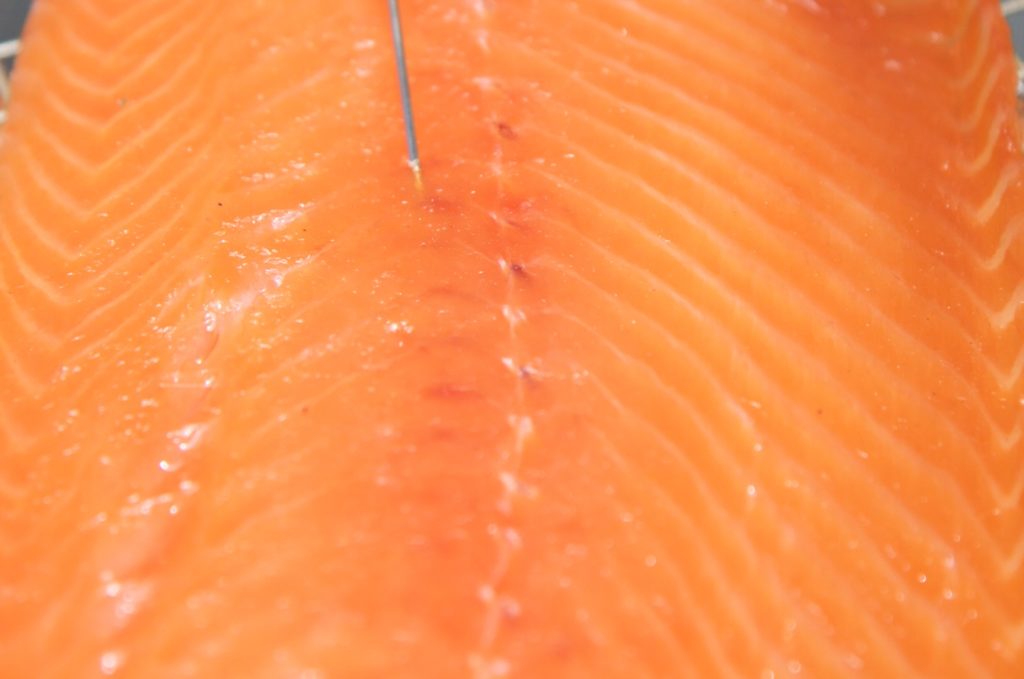
During the salt cure, water-soluble proteins—mainly myosin—are brought to the surface of the fish. When the salmon’s surface moisture dries after curing, this dissolved layer of myosin develops a sticky, shiny gel on the surface called a pellicle. The pellicle helps the fish to retain its moisture and aids in smoke penetration during the cook. A fully-developed pellicle is very important to the quality of the final product. Without this tacky skin, the salmon would become very dry. In the recipe instructions below, we have a great tip from Steven Raichlen that gives this process a boost.
The Thermal Difference Between Hot and Cold Smoking
➤ Cold Smoking:
Cold-smoking is a method of preserving fish where the ambient cooking temperature stays in the range of 68-86°F (20-30°C) for 6-12 hours. The flesh loses some of its moisture and becomes denser without being cooked. The exterior of the meat remains soft rather than hardening as it would when cooked at higher temperatures.
The obvious issue with cold-smoking is the fact that the meat remains in the temperature danger zone (40-140°F [4-60°C]) for several hours. The antimicrobial properties of dry-curing and smoking are what make the salmon safe to eat, but this method may be best left to seafood processing experts with strict sanitation and safety measures in place to monitor pH and water activity to ensure the end result is pathogen-free. We recommend a hot-smoking method that is safer and yields a moist, flaky result that doesn’t disappoint.
➤ Hot-Smoking:
Hot-smoking takes place with an ambient temperature in the range of 150-170°F (66-77°C), well above the danger zone. The fish is smoked until the internal temperature of the meat reaches your desired degree of doneness. The higher cooking temperature will kill any existing microbes so you’re guaranteed that the salmon is safe to eat. To keep the smoker’s cook temp in this range, an accurate thermometer with an air probe and a low alarm (like ThermaQ®) is critical.
Fish Temperatures From Raw to Overcooked:
In his book On Food and Cooking, Harold McGee outlines what happens to the fish at different temperatures during cooking, and its characteristics at those temps.
- 70°F: Soft, slick, smooth, and translucent. Fiber-weakening enzymes are active, and some water begins to escape.
- 100°F: Soft, slick, smooth and translucent with a wet surface due to accelerated water leaking from protein cells.
- 110°F: Protein begins to shrink, the flesh becomes firmer, opaque, and juice is exuded.
- 120°F: Flesh continues to shrink and becomes resilient, is less slick and more fibrous, opaque, and exudes juice when chewed or cut.
- 130°F: Sheets of protein begin to separate and become flaky, fiber-weakening enzymes denature and become inactive.
- 140°F: Proteins continue to shrink, the texture becomes firm, fibrous, and fragile, and little free juice is left. Collagen dissolves into gelatin.
- 150°F: Protein is becoming progressively more firm, dry, flaky, and fragile.
- 160°F: The flesh is stiff and dry. All protein fibers have denatured and coagulated.
For more on salmon temps, as well as other seafood temps, take a look at our recommended temperatures for seafood!
☼ Recommended Smoking Thermometer:
ThermaQ is our thermometer of choice for this project because of its dual channels to monitor both the smoker and meat temp, precision accuracy with thermocouple probes, and the high and low alarms that make tracking the cook temperature range easy.
Smoker Temperature and Meat Pull Temperature
In order to preserve as much of the soft, dense quality of cold-smoked salmon as we can, we’re going to smoke ours at a relatively low 150°F (66°C) and pull it once the internal temperature reaches 120°F (49°C). Harold McGee gives a recommended internal temperature range of 120-135°F (49-57°C) for fish because that is the point when its tender protein begins to firm and turn opaque, yet is still juicy. Higher temperatures will yield a salmon fillet that is too dry.
Smoked salmon is something that can certainly be done at home, even if it’s your first time. The only sure way to know exactly when the salmon has reached its perfect texture is through carefully tracking its internal temperature. If you’re a fan of smoked salmon, grab a ThermaQ and give this project a try—it may turn into one of your favorites!
Print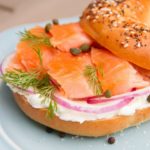
Smoked Salmon: Key Temperatures For Success
Description
Smoked Salmon
Ingredients
- 1, 2-1/4 to 2-1/2 lb. salmon fillet
- 1 C kosher salt
- 1/2 C granulated sugar
- 1/2 C brown sugar
- 1 Tbsp whole black peppercorns
- Plastic wrap and heavy-duty aluminum foil
- Hardwood chips (apple or cherry)
*For food safety and to keep protein fiber weakening enzymes as dormant as possible, mindfully keep the fish at or below 40°F (4°C) through preparation until beginning to smoke. For the best quality and texture, purchase fresh salmon, or thaw frozen salmon no more than 1 day before curing.
Instructions

- Combine salt, sugars, and peppercorns in a small bowl and set dry cure aside.
- Prepare enough aluminum foil to cover the fillet on top of a sheet pan and set aside.
- Lay out enough plastic wrap on the countertop to cover the length of the fillet and wrap around it. Sprinkle half of the dry cure in the center of the arranged plastic wrap in about the shape and size of the fillet.

- Place the salmon fillet over the cure sprinkled on the plastic wrap and apply the rest of the cure evenly onto the top side of the fillet, being sure to cover the sides.
- Wrap the fillet securely with plastic. Place the wrapped salmon in the center of the prepared foil and wrap securely. Position the fillet in the sheet pan so it is completely contained.

- Place another sheet pan on top of the double-wrapped fish and weigh down with about 3-4 pounds. We used a bag of dry beans we use for blind baking pie shells. Cans of soup, a phone book, or really anything else that can withstand refrigerator temperatures in that weight range will work. Refrigerate for 24 hours.

- Weigh it down.
- Weighing down the salmon is an important step during the cure. This provides very close contact between the fish’s flesh and the ingredients of the cure. Excess fluid will be pressed from the fish, and compact the flesh.

Cook Day:
- After the 24-hour cure, unwrap the salmon and rinse off thoroughly under cold water.
- Moisture will have been drawn out of the salmon, the flesh will be more firm, and the color more intense.

- Pat completely dry, place fillet on a wire cooling rack over a sheet pan and refrigerate uncovered until a pellicle forms. It can take several hours and up to overnight for the pellicle to form with this method.
- To speed up the process we took some advice from Steven Raichlen. Spray nonstick cooking spray onto a wire cooling rack and place the cured salmon on top, and put on the middle rack of your oven—with the oven off. Keep the door open and set a fan in front of the oven (pictured below). The circulating air around the salmon will help dry out the surface, forming the critical pellicle. This reduces the drying time to only 1-2 hours (pretty neat trick). When an adequate pellicle has formed, the surface of the fish should feel matte-like and tacky—perfect for absorbing smoke!
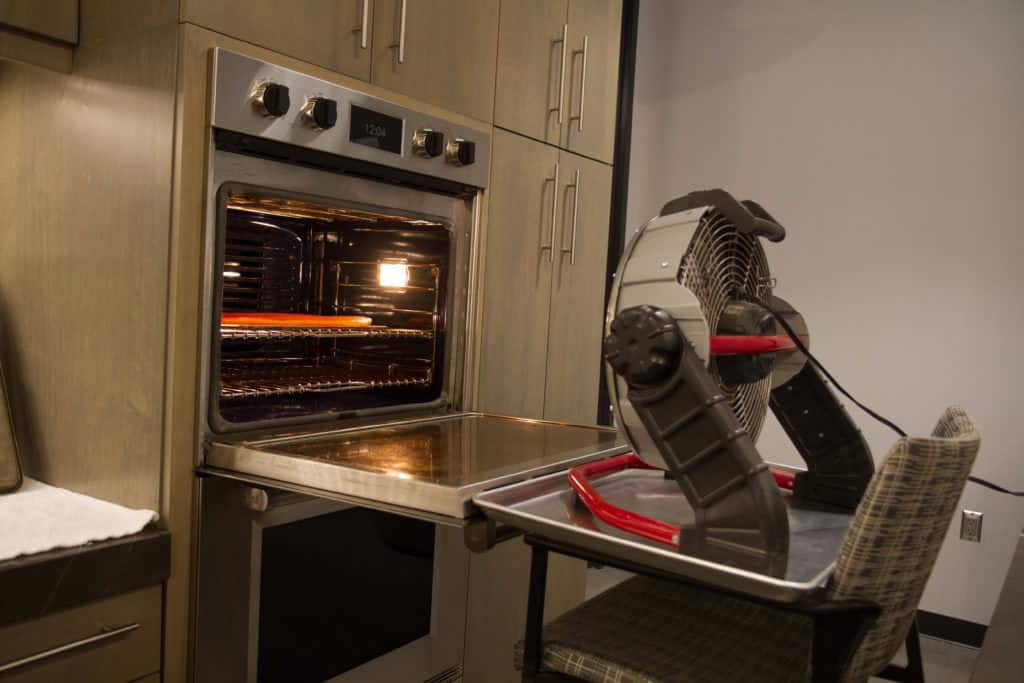
- Preheat smoker to 150°F (66°C). We used a ThermaQ dual-channel alarm thermometer to track both the interior smoker temperature and the interior temp of the salmon. Secure the air probe in the smoker with a grate clip , set the ThermaQ’s low alarm to 140°F (60°C) and the high alarm to 160°F (71°C). Use hardwood wood chips (apple or cherry) for the smoke.

- Once the pellicle has formed and the smoker is ready, remove the fillet from the refrigerator, place the ThermaQ’s needle probe into the thickest part of the meat and carefully transfer salmon to the grate. Close the lid and set the needle probe’s alarm to 120°F (49°C). The cook time will vary depending on the size of the fillet. Ours finished cooking in about one hour and fifteen minutes.

- Once the ThermaQ’s needle probe alarm sounds at 120°F (49°C), verify the temperature with a Thermapen® by quickly spot-checking the temperature in multiple areas.
- If a lower temperature is found, replace the needle probe and continue cooking until 120°F (49°C) is reached.
- Once the pull temperature has been verified, the finished salmon can be served immediately while hot or held for later use.
- Wrapping and refrigerating overnight and up to three days allows for the smoke flavor to “set.”
Carryover Tip:
With this fish being smoked at such a low temperature, there will be very minimal carryover cooking during the rest. We only saw a slight 1-2°F rise in temperature after removing the salmon from the smoker.

- Using a sharp knife, slice salmon crosswise and serve alone, with toast, or our choice: with a bagel, cream cheese, thinly sliced red onion, fresh dill, and capers.
Shop now for products used in this post:
Resources:
On Food and Cooking, Harold McGee
Smoking Fish FAQ, Barbecue Bible, Steven Raichlen
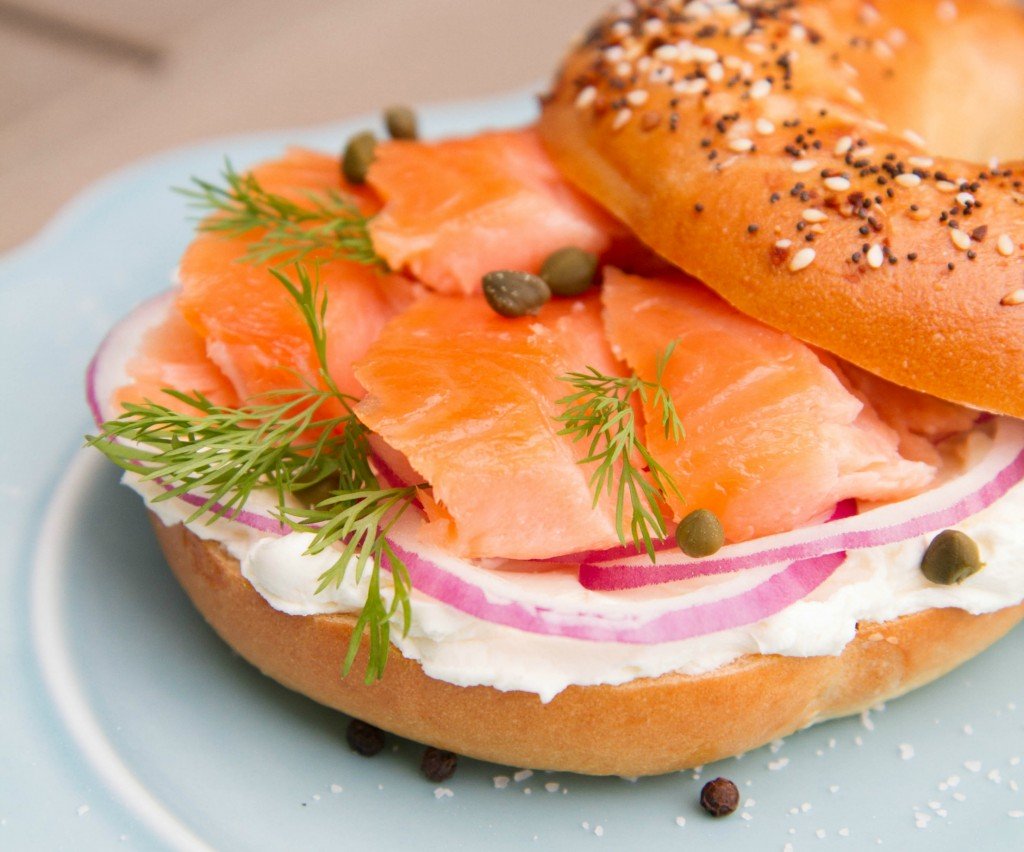
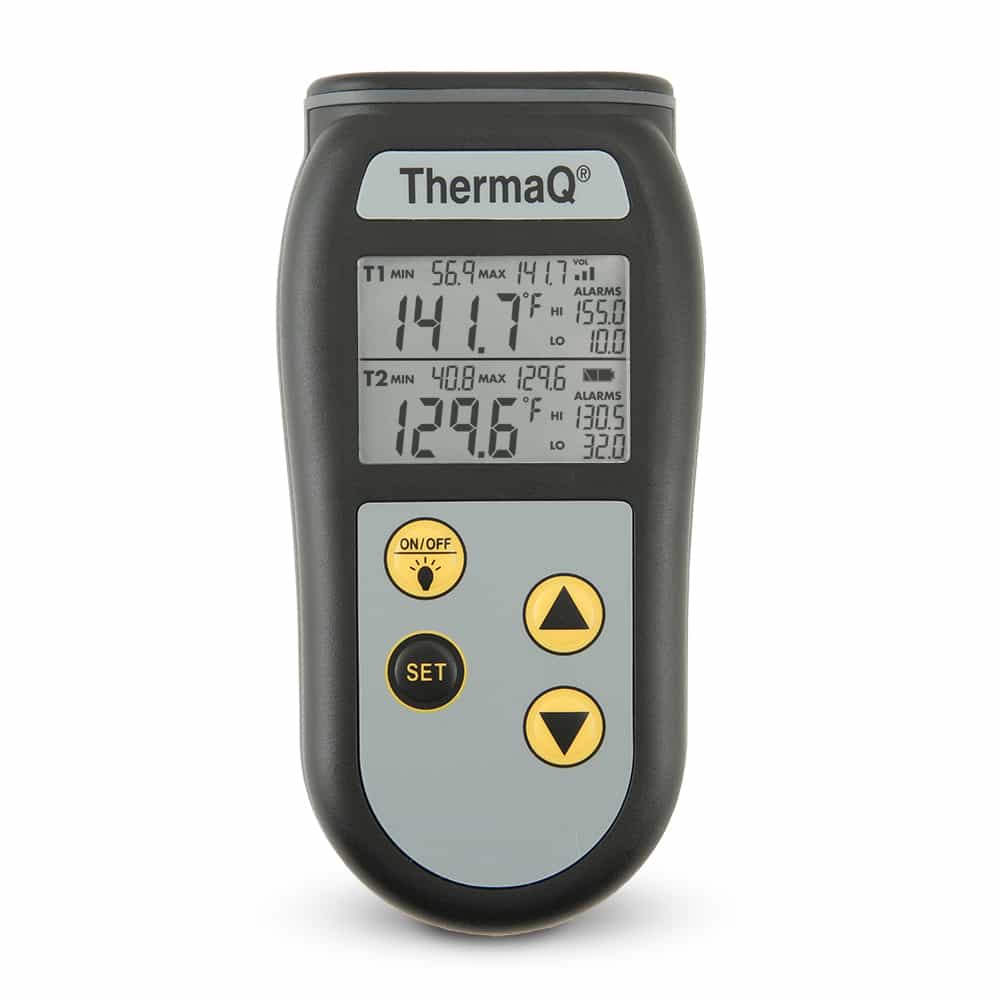


Tom Harpole says
As usual, GREAT ARTICLE… Explains to me in scientific terms what I have been doing all these years LOL! As a boy, before I could afford a smoker, I would use the weight, baking pans method on sliced beef with liquid smoke before I left it in mom’s oven most of the following day. I used my barbell weights in pie tins…..perfect fit!
….. Regarding the wood chips used, you did not mention Alder. I have found this gives a lighter “background” smoky flavor to the salmon to let the mild fish flavor come through…. Classically, I believe this is what the Indians originally used…. Of course, alder and salmon were usually found in the same locations!
Kim says
Tom,
Thank you so much for your comment. Barbells in a pie tin…brilliant! And thank you for the suggestion with using alder, next time we’ll give it a try.
-Kim
John says
Skin on or off on the filet? I have always done skin on myself as it keeps the fish together. Excited to try the dry brine as I have used a liquid brine in the past….
Kim says
John,
Thanks for your question. Our fillet was boneless and skinless, but you’re right–keeping the skin on helps the meat hold together better. If you cure with a skin-on fillet, cut three small 1/4″ deep score marks in the skin to better allow the cure to penetrate that side of the fish. Give it a try and let us know how your salmon turns out!
Thanks,
-Kim
Marko says
I followed the instructions and my salmon turned out very salty, significantly more than the store bought. What went wrong here? No enough rinsing maybe? I had it for a few seconds under the running water until I removed all peppercorns that had stuck into it.
Kim says
Marko,
You may have needed to rinse the salmon a bit more. It should be thoroughly rinsed on both sides–more than just a few seconds.
-Kim
John W. says
This sounds wonderful and I can’t wait to try it. My question is more on using your Big Green Egg though. I have a large BGE and am not sure I can hold that low of temperature without it going out. What is your method for holding the smoky fire at that temperature. I’m also thinking you probably used the plate setter with legs up???
Kim says
John,
Sorry for the tardiness in reply! Yes, ceramic diffuser with the legs up. We also use a fan in the lower vent on our BGE to keep just a few coals going at a low temperature.
Thanks,
-Kim
Jerry Burg says
I, too, was wondering if the skin was on or off. I have found that if the skin is left on, the salmon developed a distasteful fishy flavor derived from the skin. If left on, skin it as soon as it is off the grill.
Jerry
Kim says
Jerry Burg,
Our salmon was skinned. The meat is better able to absorb the cure without the skin, in addition to not having to worry about any off flavors.
Thanks!
-Kim
Priya says
I like it too you
Kevin says
I’m confused about the first step in the curing process. The instructions say to “wrap the fillet securely with plastic.” How does the liquid that’s being pressed out escape? When I make lox, I do almost the exact same process, i.e: curing, weighing it down to press out moisture overnight, etc. But, I leave the ends of the plastic wrap open so the juices can drain out.
Martin says
I don’t think there’s anything wrong with your method or with ours…the water will still be drawn out when it is tightly wrapped, it will just float around in the wrapping. Ours may come out a wee bit saltier than yours.
Randy says
The method I use is one cup kosher salt and one cup of sugar, white or brown your choice. I add this to 1 gallon of water and stirr. Add salmon to Brian mixture for three hours. Remove an air dry then add to smoker. Are usually smoke for about 4 to 5 hours at 150°F a little longer if the fillets are thick and my choice of chips are hickory
Rob says
The pic of your cold-smoked salmon once sliced, seems to show that the smoke temp was too high, as the sliced fish has broken apart (flaked) a little.